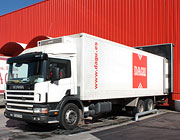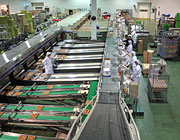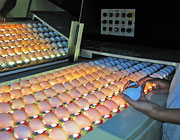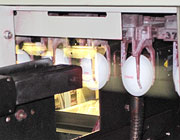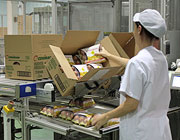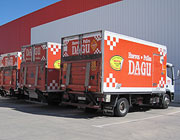Our quality system is focused on constant improvement; our aim is to progress towards achieving a better product and our customers' satisfaction. That is why all the phases an egg goes through are carefully controlled and monitored by our Quality Control Department.
The working order of the machines is checked and calibrated periodically by our maintenance staff and also by external professional services, so as to guarantee an optimum working order. Furthermore, in DAGU SA we take special care in our employees' formation and awareness. This is because we understand that this is only way we can guarantee the correct manipulation of our products.
Our Quality Department conducts an exhaustive control of the entire productive process. We also share the UE's strategy on Food Safety and we know that all the stages included in "From the farm to the fork" are equally important for our customers and they must have a top quality product at their disposal.
Thus, we understand that we must control each of the production stages, starting from the food feed for our layers to the internal quality of the eggs that we market, to guarantee the quality and safety of our products. Our philosophy is to cover the entire production process, and that not a single detail escapes our control. That is why we have made a great effort, both in equipment and workforce.
Process for grading eggs
The eggs are collected in the farms daily, where a first selection is made, separating the eggs that can't be graded (i.e. deformed, dirty, etc.). Only eggs fit for transport to the grading station are loaded onto trolleys, which are then identified according to the requirements established by the legislation and our own traceability system. This way, at any given time, we know the origin of the eggs or when they were laid, as this data is registered on all the trolleys.
Reception
The eggs are collected from the farms and forwarded to the Grading Station where, only after a visual inspection and when the documents have been accepted, are the eggs stored under a controlled temperature.
The laboratory staff perform different physical, chemical and microbiological tests to determine if the batch is accepted and on some occasions to penalize the supplier according to the Quality parameters.
Once the batch is approved for grading, the eggs then go from the reception area to the grading room, where they are placed on the grading machines. These machines can grade up to 100,000 eggs an hour.
Candling
Once the eggs have been loaded onto the grader, first they are graded according to their quality. A-Cat eggs, assigned to the consumer, are whole eggs with an air-cell of less than 6 mm. Cat-B eggs are cracked and dirty eggs which are used for industry. This process can be done either automatically, using artificial vision technique and analysis by ultrasounds or with properly trained operators who performs this task manually.
Grading by weight
The next step is to grade the eggs according to their weight. The legislation establishes four weight categories: S (<53 gr), M ( 53-63 gr), L ( 63-73 gr) and XL ( >73 gr).
Marking
Once they have been weighed, the farm code and, on some occasions the best before date, are printed on the eggs.
Packing and wrapping
Once the eggs have been graded, they are placed in different types of packs. These are then placed in boxes, rolls or pallets. The boxes are sent along the transport belts to an automatic palletizer and then they are taken to the shipping storage centre, where the temperature is closely monitored to preserve the quality of the product. All the packs and wrappings are then labelled appropriately, keeping the traceability of the product and processes.
Shipping
Specially equipped lorries are used for their transport and the eggs are loaded and secured firmly to avoid them moving during the transport.
Both technical and human means are of utmost importance so that the entire process goes smoothly and that is why we make special emphasis on the maintenance of the equipment and we pay special attention to the training and awareness of our workforce, as this is the only way to guarantee the correct handling of the product.
